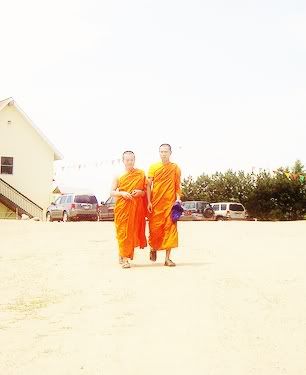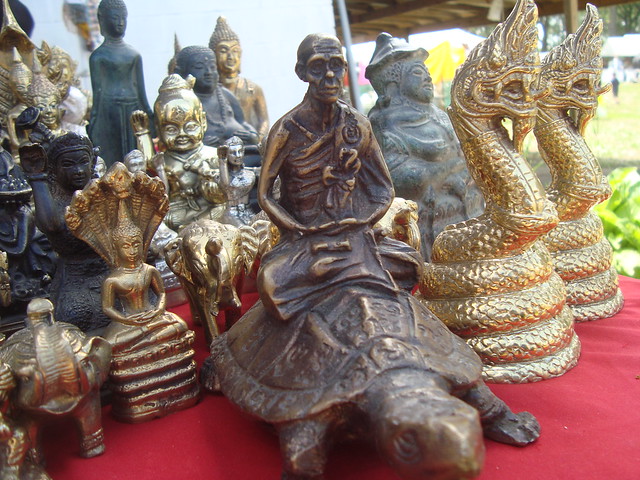But I also want to make sure my readers understand that what I'm presenting in these small discussions should by no means be considered the definitive 'meaning' of the poem. A poem means what it means to the reader. An author has ideas and things in mind when they write it, but a true poem is a living thing whose interpretation can change when it goes to different countries and different eras.
For example: A zombie in an earlier era was a thing to be pitied, a slave created against their will with no hope of recovery. That was the root of the horror for those beings. A zombie in a later era became a metaphor for mindless horde consumerism. So poems which feature zombies written in one age may have a very different reading in another. Some authors may object to that fluidity of interpretation, but I do not. I'm open to outcome, not attached to outcome, whenever possible.

But let's take a look at my poem "Idle Fears," which first appeared in 2012 in the Buddhist Poetry Review, along with "The Buddha of Bombies" and "A Koan of 32 Kwan." I didn't include these other two in DEMONSTRA because I felt that much of the territory they covered was addressed in other poems. I don't like belaboring a point too much in a poetry manuscript. You can revisit it in another book, certainly, but don't imbalance a text through overtalking. Granted there's no hard and fast rule about this, like "5 poems is one poem too many about Topic X!" but you get a feel for it over time.
I chose to open with "Idle Fears" as the gateway poem in DEMONSTRA. It embraces the Laoglish and many of the themes that I explore throughout the rest of the text, but it's also brief enough that someone picking it up can determine quickly enough if this poet's going to be someone to stick with. Or, someone whose book "should not be put down gently, but hurled, with great force."
The opening line frames our setting, a Cali wat Lao, and opens questions of how we use language to navigate the vernacular and the unfamiliar. Overall, "Idle Fears" stayed in much the same form as its first draft in 2012, which is something of a rarity for my writing process.
The recurring figure of Ajahn Anan is first introduced in this poem. He was inspired by a few young monks I met in Southern California. Although this specific conversation never took place, similar conversations have, although I'm taking some poetic liberties here. Many of the poems in DEMONSTRA are originally designed to ask us to consider how we might hope our monks, our families and friends might talk with us in our communities.

The Rakshasa Sutra is one of the first imagined books that will get proposed in DEMONSTRA. In the White Lotus Sutra, there are tales of Rakshasa daughters who pledge to protect the dharma of the Buddha. They swore to inflict great harm on those who corrupt his teachings. You can find numerous anecdotes that suggest the Buddha lectured to various gods, demons, and other personages throughout creation, not just humanity, and that each of these might have unique routes to enlightenment that other species do not. And perhaps unique perils. So, the Rakshasa Sutra is a hypothetical text that outlines the Buddha's lecture to them, but it is also most likely not meant for human eyes. The Rakshasha legends form the root for the Nyak of Laos, but I think a study of the extant literature suggests Lao storytellers often ignore or alter some of their powers, personalities, significance, and other characteristics from time to time.
As we wind our way through "Idle Fears," we have the question “Does a zombie have Buddha nature?” This is an iteration on a classic zen koan, a riddle for Buddhist meditation "Does a dog have Buddha nature." In contrast, we have another 'undead' entity, Frankenstein’s Monster, coming into play in "Idle Fears." Is he a candidate capable of enlightenment? As a composite entity, Frankenstein's Monster might have a very unique perspective on attachment, and also a sense of re-attachment. I wondered how that would affect him if he were to give up seeking revenge and instead turn towards a Buddhist route.
I often joked of "An American Werewolf in Luang Prabang" as opposed to one in London or Paris. This poem is one where, like many of our Lao writers, I examine the interpretations of the five Buddhist precepts. We often repeat them, but I think more can be done by every generation to meaningfully explore the challenges in observing them.
This poem also takes on the notion of‘Wat Lao Robobuddharam,’ a play on the way many Lao temples are named in the US. Later in DEMONSTRA I experimented with more science fiction in the poems, notable examples including "The Robo Sutra" and "Full Metal Hanoumane."
"Idle Fears" isn't an encyclopedic demonstration of all of the techniques and themes I address in the rest of DEMONSTRA, but I consider it a playful enough sample that it made sense for it to lead into the rest of the manuscript.



No comments:
Post a Comment